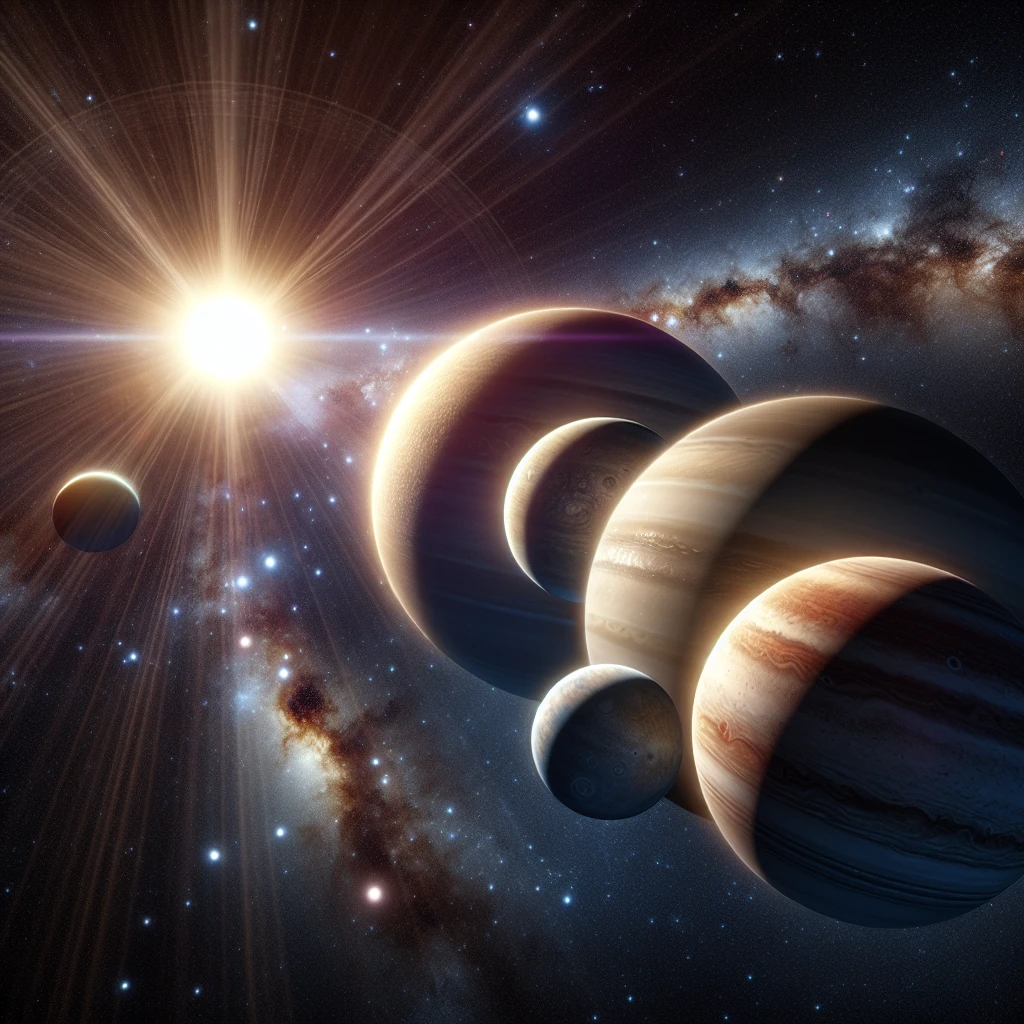Scientists have discovered a “perfect solar system” that is ideal for studying how planets form and whether they can support life. Located 100 light years away, this system has six planets that are all about the same size and have remained unchanged for up to 12 billion years. In contrast, our own solar system was formed through violent collisions, resulting in planets of different sizes. The planets in this new system, named HD110067, rotate in sync and have a precise pattern of relative orbit speeds. Researchers have even created a musical composition based on this planetary choreography.
Dr Rafael Luque, who led the research, described HD110067 as “the perfect solar system” because it didn’t have the chaotic beginnings that our own system had. Dr Marina Lafarga-Magro added that the system was “beautiful and unique” and that it was exciting to see something that no one had seen before. This system is of great interest to astronomers because its undisturbed nature and the near-identical size of its planets make it easier to study how planets form and evolve. Additionally, the system has a bright star, which makes it easier to search for signs of life in the planets’ atmospheres.
All six planets in this system are classified as “sub-Neptunes,” which are larger than Earth but smaller than Neptune. These types of planets are thought to be the most common in the galaxy, yet astronomers know very little about them. The discovery of HD110067 provides an opportunity to learn more about these planets and whether they can support life. If the next round of observations indicates that sub-Neptunes can indeed support life, it greatly increases the chances of finding signs of life on other planets.
Scientists are now racing to detect biosignatures on one of the six new sub-Neptunes or on other similar planets discovered by different groups. With the help of advanced telescopes and new technologies, many astronomers believe that the search for alien life may not take too long. The planets in HD110067 were discovered using NASA’s Transiting Exoplanet Survey Satellite (TESS) and ESA’s CHaracterising ExOPlanet Satellite (Cheops).
Original news source: Perfect solar system’ found in search for alien life (BBC)
Listen
Slow
Normal
Fast
Group or Classroom Activities
Warm-up Activities:
– News Summary
Instructions:
1. Divide the class into small groups.
2. Give each group a copy of the article.
3. Have each group read the article silently and discuss the main points.
4. Instruct each group to create a concise summary of the article, highlighting the key information.
5. After a designated amount of time, have each group share their summary with the class.
– Opinion Poll
Instructions:
1. Divide the class into pairs.
2. Give each pair a copy of the article.
3. Instruct each pair to read the article and discuss their opinions on the discovery of the “perfect solar system” and the possibility of finding signs of life on other planets.
4. After the discussion, have each pair come up with three poll questions related to the topic.
5. Have each pair take turns asking their poll questions to another pair, recording the responses.
6. After all pairs have asked their questions, have a class discussion sharing the different opinions and results.
– Sketch It
Instructions:
1. Divide the class into pairs.
2. Give each pair a blank sheet of paper and a pen or pencil.
3. Instruct one person in each pair to describe one of the planets in the “perfect solar system” to their partner, without using its name.
4. The other person must sketch the planet based on the description they hear.
5. After a designated amount of time, have the pairs switch roles.
6. Once both partners have had a chance to describe and sketch a planet, have them compare their sketches and discuss any similarities or differences.
– Vocabulary Pictionary
Instructions:
1. Write down 10 vocabulary words from the article on individual pieces of paper and put them in a hat or container.
2. Divide the class into two teams.
3. Have one person from each team come to the front of the class.
4. Draw a word from the hat and show it to both players.
5. Each player must take turns drawing a picture to represent the word, without using any letters or numbers.
6. The rest of the team must guess the word based on the drawing.
7. The team that guesses the word correctly earns a point.
8. Repeat the process with new players until all the words have been drawn.
– Future Predictions
Instructions:
1. Have a class discussion about the discovery of the “perfect solar system” and the potential for finding signs of life on other planets.
2. Ask each student to make a prediction about what they think will happen in the future regarding the search for alien life.
3. Instruct each student to write their prediction down on a piece of paper, without sharing it with anyone.
4. After everyone has written their prediction, collect the papers and read them out loud to the class.
5. Have a class discussion about the different predictions and the reasons behind each one.
Comprehension Questions:
1. How does the HD110067 solar system differ from our own solar system?
2. Why are scientists interested in studying the HD110067 solar system?
3. What type of planets are classified as “sub-Neptunes”?
4. Why is the discovery of HD110067 significant for learning more about sub-Neptunes?
5. What are scientists racing to detect on one of the sub-Neptunes or other similar planets?
6. What technologies were used to discover the planets in the HD110067 system?
7. How does the undisturbed nature of the HD110067 system make it easier to study planet formation and evolution?
8. What are the chances of finding signs of life on other planets if sub-Neptunes can support life?
Go to answers ⇩
Listen and Fill in the Gaps:
Scientists have discovered a “perfect (1)______ system” that is ideal for studying how (2)______ form and whether they can support life. Located 100 light years away, this system has six planets that are all about the same size and have (3)______ unchanged for up to 12 billion years. In contrast, our own solar system was formed through violent collisions, (4)______ in planets of different sizes. The planets in this new system, named HD110067, rotate in sync and have a precise pattern of relative orbit speeds. Researchers have even created a musical (5)______ based on this planetary choreography.
Dr Rafael Luque, who led the research, described HD110067 as “the perfect solar (6)______” because it didn’t have the chaotic beginnings that our own system had. Dr Marina Lafarga-Magro added that the system was “beautiful and unique” and that it was exciting to see something that no one had seen before. This system is of (7)______ interest to astronomers because its (8)______ nature and the near-identical size of its planets make it easier to study how planets form and evolve. Additionally, the system has a bright star, which makes it easier to search for signs of life in the planets’ atmospheres.
All six planets in this system are (9)______ as “sub-Neptunes,” which are larger than Earth but smaller than Neptune. These types of planets are thought to be the most common in the galaxy, yet (10)______ know very little about them. The discovery of (11)______ provides an opportunity to learn more about these planets and whether they can support life. If the next round of (12)______ indicates that sub-Neptunes can indeed support life, it greatly (13)______ the chances of finding signs of life on other planets.
Scientists are now racing to detect biosignatures on one of the six new sub-Neptunes or on other (14)______ planets discovered by different groups. With the help of advanced (15)______ and new technologies, many astronomers believe that the (16)______ for alien life may not take too long. The planets in HD110067 were discovered using NASA’s Transiting Exoplanet Survey Satellite (TESS) and ESA’s CHaracterising ExOPlanet Satellite (Cheops).
Go to answers ⇩
Discussion Questions:
Students can ask a partner these questions, or discuss them as a group.
1. What do you think is the significance of discovering a “perfect solar system”?
2. How would you feel if scientists discovered signs of life on one of the sub-Neptunes in HD110067?
3. Do you think it is possible for planets in other solar systems to support life? Why or why not?
4. How do you think the discovery of HD110067 will impact our understanding of how planets form and evolve?
5. What is a biosignature and why is it important in the search for alien life?
6. Do you think the discovery of HD110067 increases the chances of finding signs of life on other planets? Why or why not?
7. How do you think the use of advanced telescopes and new technologies will aid in the search for alien life?
8. What is your opinion on the idea of alien life existing in the universe?
9. How do you think the discovery of HD110067 will impact future space exploration missions?
10. How would you feel if you were part of the team of scientists studying HD110067 and made a groundbreaking discovery?
11. Do you think it is possible for humans to eventually inhabit other planets? Why or why not?
12. How do you think the discovery of HD110067 will influence public interest in space exploration?
13. What do you think is the likelihood of finding signs of life on other planets within our lifetime?
14. How would you feel if you were able to visit HD110067 and see the “perfect solar system” in person?
15. Do you think the discovery of HD110067 will change our perspective on the uniqueness of our own solar system? Why or why not?
Individual Activities
Vocabulary Meanings:
Match each word to its meaning.
Words:
1. solar
2. planets
3. size
4. system
5. life
6. study
7. support
8. discovered
Meanings:
(a) Relating to the sun
(b) To provide assistance or help to someone or something
(c) Found or identified for the first time
(d) The dimensions or extent of something
(e) The condition that distinguishes animals and plants from inorganic matter
(f) A group of objects or elements that are connected or related
(g) Celestial bodies that orbit a star
(h) The act of examining something closely and in detail
Go to answers ⇩
Multiple Choice Questions:
1. Where is the “perfect solar system” located?
(a) In our own solar system
(b) On a different planet
(c) In a neighboring galaxy
(d) 100 light years away
2. What is unique about the planets in HD110067?
(a) They have different sizes
(b) They have chaotic beginnings
(c) They are all about the same size
(d) They rotate in opposite directions
3. What is the name of the system with the perfect solar system?
(a) TESS
(b) HD110067
(c) Cheops
(d) NASA
4. Why are astronomers interested in studying the HD110067 system?
(a) It has a bright star
(b) It is located 100 light years away
(c) It has six planets
(d) It is easier to study how planets form and evolve
5. What type of planets are classified as “sub-Neptunes”?
(a) Larger than Neptune but smaller than Earth
(b) The same size as Earth
(c) Larger than Earth but smaller than Neptune
(d) The same size as Neptune
6. What does the discovery of HD110067 provide an opportunity to learn more about?
(a) The formation of our own solar system
(b) Sub-Neptunes and their ability to support life
(c) The search for signs of life on Earth
(d) The size of Neptune
7. What technology was used to discover the planets in HD110067?
(a) NASA’s TESS and ESA’s Cheops
(b) Advanced telescopes and new technologies
(c) Biosignatures
(d) Musical compositions
8. What are scientists racing to detect on one of the sub-Neptunes?
(a) Biosignatures
(b) Signs of life on Earth
(c) Signs of life on other planets
(d) Signs of life in the planets’ atmospheres
Go to answers ⇩
True or False Questions:
1. The planets in this solar system have not remained unchanged for up to 12 billion years.
2. Scientists have not discovered a solar system that is ideal for studying how planets form and whether they can support life.
3. The discovery of this solar system does not provide an opportunity to learn more about sub-Neptunes and whether they can support life.
4. This solar system is not located 100 light years away from Earth.
5. All six planets in this solar system are classified as “sub-Neptunes.”
6. Scientists are racing to detect biosignatures on one of the six new sub-Neptunes or on other similar planets discovered by different groups.
7. Researchers have created a musical composition based on the planetary choreography of this solar system.
8. The planets in this solar system rotate in sync and have a precise pattern of relative orbit speeds.
Go to answers ⇩
Write a Summary:
Write a summary of this news article in two sentences.
Check your writing now with the best free AI for English writing!
Writing Questions:
Answer the following questions. Write as much as you can for each answer.
Check your answers with our free English writing assistant!
1. What makes the solar system HD110067 unique and ideal for studying how planets form?
2. How do the planets in HD110067 differ from the planets in our own solar system?
3. Why are astronomers particularly interested in studying sub-Neptunes like the ones in HD110067?
4. What are scientists hoping to find on one of the sub-Neptunes in HD110067 or other similar planets?
5. What technologies were used to discover the planets in HD110067?
Answers
Comprehension Question Answers:
1. How does the HD110067 solar system differ from our own solar system?
– The HD110067 solar system has six planets that are all about the same size and have remained unchanged for up to 12 billion years, while our solar system has planets of different sizes formed through violent collisions.
2. Why are scientists interested in studying the HD110067 solar system?
– Scientists are interested in studying the HD110067 solar system because its undisturbed nature and the near-identical size of its planets make it easier to study how planets form and evolve. Additionally, the system has a bright star, which makes it easier to search for signs of life in the planets’ atmospheres.
3. What type of planets are classified as “sub-Neptunes”?
– “Sub-Neptunes” are planets that are larger than Earth but smaller than Neptune.
4. Why is the discovery of HD110067 significant for learning more about sub-Neptunes?
– The discovery of HD110067 is significant for learning more about sub-Neptunes because it provides an opportunity to study these types of planets, which are thought to be the most common in the galaxy. By studying HD110067 and its planets, scientists can learn more about the formation and evolution of sub-Neptunes and whether they can support life.
5. What are scientists racing to detect on one of the sub-Neptunes or other similar planets?
– Scientists are racing to detect biosignatures on one of the sub-Neptunes or other similar planets. Biosignatures are signs of life, such as the presence of certain molecules or gases in a planet’s atmosphere.
6. What technologies were used to discover the planets in the HD110067 system?
– The planets in the HD110067 system were discovered using NASA’s Transiting Exoplanet Survey Satellite (TESS) and ESA’s CHaracterising ExOPlanet Satellite (Cheops).
7. How does the undisturbed nature of the HD110067 system make it easier to study planet formation and evolution?
– The undisturbed nature of the HD110067 system makes it easier to study planet formation and evolution because the planets in this system have remained unchanged for up to 12 billion years. This allows scientists to observe the planets in their original state and understand how they formed and evolved over time.
8. What are the chances of finding signs of life on other planets if sub-Neptunes can support life?
– If sub-Neptunes can support life, the chances of finding signs of life on other planets increase greatly. Since sub-Neptunes are thought to be the most common type of planet in the galaxy, discovering that they can support life would suggest that the potential for life on other planets is also high.
Go back to questions ⇧
Listen and Fill in the Gaps Answers:
(1) solar
(2) planets
(3) remained
(4) resulting
(5) composition
(6) system
(7) great
(8) undisturbed
(9) classified
(10) astronomers
(11) HD110067
(12) observations
(13) increases
(14) similar
(15) telescopes
(16) search
Go back to questions ⇧
Vocabulary Meanings Answers:
1. solar
Answer: (a) Relating to the sun
2. planets
Answer: (g) Celestial bodies that orbit a star
3. size
Answer: (d) The dimensions or extent of something
4. system
Answer: (f) A group of objects or elements that are connected or related
5. life
Answer: (e) The condition that distinguishes animals and plants from inorganic matter
6. study
Answer: (h) The act of examining something closely and in detail
7. support
Answer: (b) To provide assistance or help to someone or something
8. discovered
Answer: (c) Found or identified for the first time
Go back to questions ⇧
Multiple Choice Answers:
1. Where is the “perfect solar system” located?
Answer: (d) 100 light years away
2. What is unique about the planets in HD110067?
Answer: (c) They are all about the same size
3. What is the name of the system with the perfect solar system?
Answer: (b) HD110067
4. Why are astronomers interested in studying the HD110067 system?
Answer: (d) It is easier to study how planets form and evolve
5. What type of planets are classified as “sub-Neptunes”?
Answer: (c) Larger than Earth but smaller than Neptune
6. What does the discovery of HD110067 provide an opportunity to learn more about?
Answer: (b) Sub-Neptunes and their ability to support life
7. What technology was used to discover the planets in HD110067?
Answer: (a) NASA’s TESS and ESA’s Cheops
8. What are scientists racing to detect on one of the sub-Neptunes?
Answer: (a) Biosignatures
Go back to questions ⇧
True or False Answers:
1. The planets in this solar system have not remained unchanged for up to 12 billion years. (Answer: False)
2. Scientists have not discovered a solar system that is ideal for studying how planets form and whether they can support life. (Answer: False)
3. The discovery of this solar system does not provide an opportunity to learn more about sub-Neptunes and whether they can support life. (Answer: False)
4. This solar system is not located 100 light years away from Earth. (Answer: False)
5. All six planets in this solar system are classified as “sub-Neptunes.” (Answer: True)
6. Scientists are racing to detect biosignatures on one of the six new sub-Neptunes or on other similar planets discovered by different groups. (Answer: True)
7. Researchers have created a musical composition based on the planetary choreography of this solar system. (Answer: True)
8. The planets in this solar system rotate in sync and have a precise pattern of relative orbit speeds. (Answer: True)
Go back to questions ⇧













